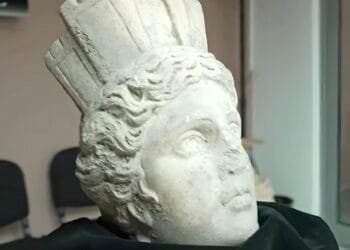The face of a 2,000-year-old Egyptian mummy, who may have been pregnant when she died, has been reconstructed. Researchers estimate she died around 2,000 years ago, while 28 weeks pregnant, and was most likely between the ages of 20 and 30.

The “Mysterious Lady” is reported to have been discovered in royal tombs in Thebes, Upper Egypt, belonging to the Theban nobility. Her mummy was discovered in the early 1800s and dated from the first century BC, during Cleopatra’s reign and when Thebes was a hive of activity.
In December 1826, the mummy was transported from Egypt to Warsaw. The mummy, which is presently on display at the National Museum in Warsaw, is thought to be the first embalmed specimen known to contain a foetus.
Now two facial approaches from forensic scientists offer new insights into what that ancient Egyptian woman might have looked like, revealing yet another mystery she’s kept hidden for centuries.
Forensic experts worked on facial reconstructions of the mummy using CT scans and X-rays, resulting in two different interpretations of the woman’s likeness. The dark-skinned young woman with brown eyes is shown looking straight ahead in both reconstructions, presenting a realistic image of her lost in thought.
“Modern techniques enable us to perform a virtual autopsy of the mummy,” Wojciech Ejsmond co-director of the Warsaw Mummy Project, told Live Science. “We can look under the bandages and inside her body. For the first time her face will be revealed to the general public and everyone will be able to look at her face.”
“Whether archaeological or forensic facial reconstruction is performed, facial reconstruction should not be viewed as an exact portrait of the individual.” Chantal Milani, a forensic science specialist who worked on the project, told Live Science in an email.
“However, it is based on the principle that the skull, like most anatomical structures, has details, proportions and shapes that are individual to that person and are manifested through the soft tissues, lending a personal character to the final appearance.”

“The face, which covers the bone structure, follows different anatomical rules, so standard methods can be used to reconstruct it, for example to determine the shape of the nose. The most important element is the reconstruction of the thickness of the soft tissues in numerous places on the surface of the facial bones. For that, we have statistical data for different populations around the world,” she noted.
Related: Pregnant Egyptian mummy ‘Mysterious Lady’ may have died of cancer
According to forensic artist Hew Morrison, ‘Facial reconstruction is mainly used in forensics to help determine the identity of a body when more common means of identification such as fingerprint identification or DNA analysis have drawn a blank.
It can also be used in archaeological and historical contexts to show how ancient people or notable figures from the past would have appeared in life.



























